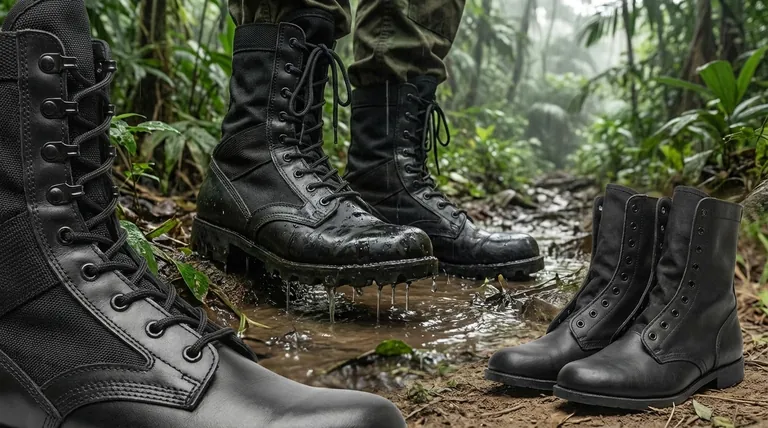To identify fake jungle boots, look for three primary indicators: a cheap lacing system using simple punched holes instead of a proper speed-lacing system, soles that are poorly glued on and prone to detachment, and a lack of authentic user reviews confirming durability in wet conditions.
The core issue is that counterfeit jungle boots are built for appearance, not function. Genuine boots are defined by specific, durable features designed to perform in wet, demanding environments—features that fakes invariably sacrifice to cut costs.

The Hallmarks of a Genuine Jungle Boot
To spot a fake, you must first understand the functional design of an authentic jungle boot. These are not fashion items; they are tools engineered for a specific, harsh environment.
The Lacing System: Speed and Security
A genuine military-style jungle boot almost always features a speed lacing system. This system uses a combination of traditional eyelets on the lower portion and sturdy hooks or rings on the upper ankle support.
This design allows for rapid tightening and loosening, which is critical in the field. Fakes often skip this for simple punched holes all the way to the top, which is a significant red flag.
Sole Construction: The Foundation of Durability
The sole is where most fakes fail catastrophically. Authentic jungle boots often feature a direct-molded sole (DMS) or a vulcanized rubber sole, like the classic Panama sole.
This construction method fuses the sole to the boot's upper, creating a single, incredibly durable unit that resists separation even when constantly soaked. Fakes typically use cheap glue, which quickly dissolves and leads to sole detachment in wet conditions.
Drainage Vents: The Unmistakable Sign
Perhaps the most crucial feature is the inclusion of drainage vents. These are small, screened metal eyelets located on the inner instep of the boot.
Their sole purpose is to pump water out of the boot with each step, allowing the foot to dry faster and preventing immersion foot. The absence of these vents is an almost certain sign of a counterfeit or a low-quality replica not intended for actual jungle use.
Common Pitfalls and Red Flags
When inspecting a potential purchase, be hyper-vigilant for signs of cost-cutting that compromise the boot's integrity.
Inspect the Materials and Stitching
Genuine boots use durable materials like full-grain leather and heavy-duty Cordura nylon. Stitching will be neat, dense, and often double- or triple-stitched in high-stress areas.
Counterfeits often use flimsy synthetic materials and sloppy, single-thread stitching that will not withstand rugged use.
Question the Seller and Price
If a price seems too good to be true for a military-specification boot, it almost certainly is. Authentic, durable footwear has a baseline cost.
Purchase from reputable military surplus stores or established outdoor gear retailers. Be highly suspicious of unknown third-party sellers with generic product descriptions and a lack of credible, detailed reviews.
Differentiate "Replica" from "Fake"
It's important to understand the difference between a "fake" and a "replica." A replica is a commercially produced boot that mimics the style of a jungle boot for casual or costume wear and is sold as such.
A fake or counterfeit is deceptively marketed as a genuine, durable piece of equipment. While a replica may be fine for light use, a counterfeit is a liability that will fail under any real stress.
Making a Confident Purchase
Your choice should be dictated entirely by your intended use. A boot for a costume has different requirements than one for a multi-day hike through a swamp.
- If your primary focus is maximum durability for harsh, wet conditions: Insist on a boot from a reputable brand with a direct-molded or vulcanized Panama sole and functional drainage vents.
- If your primary focus is casual wear or light use: A well-reviewed commercial replica may suffice, but still prioritize quality stitching and avoid any boot with obviously poor glue work around the sole.
Ultimately, investing in authentic gear means trusting that it will not fail you when you need it most.
Summary Table:
| Feature | Genuine Jungle Boot | Fake/Counterfeit Boot |
|---|---|---|
| Lacing System | Speed-lacing with hooks/rings | Simple punched holes |
| Sole Construction | Direct-molded or vulcanized (e.g., Panama sole) | Poorly glued, prone to detachment |
| Drainage Vents | Present on inner instep | Absent or non-functional |
| Materials & Stitching | Durable full-grain leather/Cordura, reinforced stitching | Flimsy synthetics, sloppy stitching |
| Intended Use | Rugged, wet environments | Appearance-only, fails under stress |
Need reliable jungle boots built for performance, not just looks?
As a large-scale manufacturer, 3515 produces a comprehensive range of durable footwear for distributors, brand owners, and bulk clients. Our production capabilities ensure every boot meets rigorous standards for sole adhesion, material quality, and functional design—perfect for customers who demand authenticity and durability.
Contact us today to discuss your footwear needs and get trusted, high-performance solutions.
Visual Guide

Related Products
- Durable Military Combat Boots with Water Drainage for Wholesale & OEM
- Wholesale Waterproof Tactical Boots Custom Suede & High-Traction Soles
- Durable Leather Tactical Boots Wholesale & Custom Manufacturing for Brands
- Wholesale Lightweight Tactical Boots with Dial Closure OEM & Bulk Orders
- Durable Leather High-Ankle Tactical Boots for Wholesale & Custom Manufacturing
People Also Ask
- How do luxurious ostrich leather shoes differ from traditional dress shoes? A Guide to Texture & Comfort
- How did combat boots transition from military use to popular culture? From Battlefield to Fashion Statement
- How do tactical boots and combat boots compare in breathability? Tactical Boots Offer Superior Airflow
- How can a shiny finish be achieved on military boots? A Step-by-Step Guide to a Mirror Shine
- What are the key features of the new Army Jungle Combat Boot? A Breakdown for Hot & Wet Environments



















